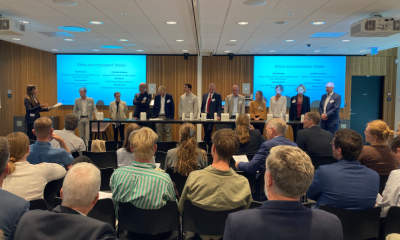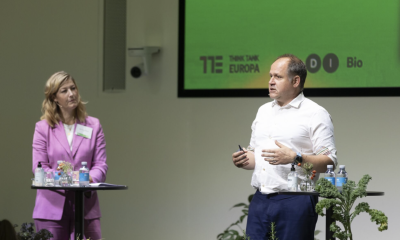High-level insights: Should we allow gene-edited plants on European fields?
On December 19th, 2022, Think Tank EUROPA hosted a webinar on the forthcoming EU NGT-regulation. This note summarises the high-level insights from the webinar.


In the webinar the Director of Think Tank EUROPA, Lykke Friis, sat down for a discussion with Svend Christensen, the Head of Department for Plant and Environmental Sciences at the University of Copenhagen,Trine Barrett Weinreich, the Director of Arlagården, Mads Flarup Christensen, the Executive Director of Greenpeace Nordics, and Birger Eriksen, the CEO of Sejet Plant Breeding. During the hour-long webinar, the guests shared their views on the challenges and opportunities of allowing precision-bred plants on European fields.
STATE OF PLAY: NGTs in Europe
In the 2nd quarter of 2023, the European Commission is expected to propose a long-awaited update to the framework for regulating plants produced by New Genomic Techniques (NGTs).[1] This follows a ruling from the European Court of Justice in 2018, which affirmed that under the current legislative framework for regulating GM plants, plants produced by NGTs should be considered as GMOs. While the decision was lauded by many environmentalist groups, it prompted the Council of the EU to request a study from the European Commission on the state of current knowledge of NGTs. Since the publication of this study in 2021, the war in Ukraine has underscored the urgency of supporting the development of technological solutions that can contribute to European and global food security.
According to the European Commission NGTs are “techniques that are capable of altering the genetic material of an organism and that have emerged or have been mainly developed since 2001.” The most well-known among these techniques is the CRISPR technology, which is used for gene-editing. NGTs cover a broad range of techniques, which are associated with different characteristics. The Commission’s study finds that some NGTs are more efficient and precise than established genomic techniques.
The Commission’s study confirms that there is growing interest in NGT research, with much of this research taking place outside of the EU. The study finds that some plant products obtained from NGTs can contribute to the objectives of the Farm to Fork and biodiversity strategies. The study also notes that the pace of innovation in the field of NGT research is high and that this poses, and is likely to continue to pose, challenges to regulating NGTs. Hence, the current regulatory framework is no longer fit for the purpose of regulating NGTs and their associated products.[2]
LOOKING AHEAD: towards an open and frank debate about NGTs
NGTs can boost climate resilience and contribute to the EU’s green agenda
With the European Green Deal (EGD) the EU has set a series of ambitious sustainability targets for the agricultural sector including an overall 55% emission reduction target (compared to the level in 1990), a 50% reduction in the use of pesticides, and that 25% of the EU’s agricultural land be used for organic farming. Precision-bred plants have the potential to accelerate the EU’s efforts to meet these targets. It can take many years to bring a plant with a new trait to market using traditional breeding techniques. In the face of the global climate emergency, some argue that it is an ethical imperative to make use of tools, such as NGTs, that can help compress this timeline.
Marketed GMOs have a mixed sustainability track record
Over the past decades scientists have developed GM crops with numerous sustainable, food security-related, and health benefits. For example, so-called BT crops have been modified to produce natural insecticides paving the way for reducing the commercial use of insecticides in farming. Similarly, mildew-resistant pearl millet has the potential to contribute to food security, by allowing for more resilient crops.
However, at the same time, there are examples of corporations developing herbicide-resistant crops, which has led to an increased use of pesticides, counteracting the EU’s green ambitions for the agri-food sector.
Who gets to own GM crops?
While the Commission study on NGTs acknowledges the benefits of patents in promoting research and innovation, the ability of large corporations to patent GM seeds has led to farmers being trapped in cycles of dependence, as only the patent-holding corporation has the right to supply the seeds for the following year’s crop.[3] In this context, policy makers and stakeholders need to ensure that NGTs are used for the benefits of planet and consumers, rather than primarily boosting the profitability of large agro-industrial corporations.
NGTs are only one of many tools in the toolbox
As with the previous debate on GMOs, scientists and corporations working with precision-breeding need to be careful not to oversell the technology’s potential. The global agri-food system is facing serious, systemic challenges and there is a consensus among NGOs, environmental groups, and scientists that an important part of fixing the agri-food system will, among other initiatives, involve a global shift toward a plant-based diet and more organic agriculture. While we should use all tools at our disposal to improve the agri-food system, we need to be careful not to rely on innovation alone to save it.
Towards an open debate about NGTs
As we look toward a renewed debate on the environmental- and health-related risks and benefits of NGTs, it is important that we learn from the mistakes of the previous GMO-debate in Europe, where large corporations were widely perceived as overselling the benefits of gene-editing technologies. It is key that scientists, politicians, civil society, and business have an open and frank conversation with consumers about the potential benefits and risks of NGTs. As part of this, consumers must be able to make informed and meaningful choices over whether they wish to consume genetically modified food.
This event is part of Think Tank EUROPA’s Biosolutions 2030 – Towards a paradigm shift in European agricultural and food policy project and is financed by Novo Nordisk Foundation (NNF22SA0080353).
YOU CAN WATCH THE FULL RECORDING OF THE EVENT HERE.
[1] New Genomic Techniques (NGTs) refer to new techniques (e.g. CRISPR) for genetic engineering, that have been developed since 2001 when the last major legislation on genetically modified organisms was adopted.
[2] Commission Staff Working Document. Study on the status of new genomic techniques under union law and in light of the Court of Justice in case C-528/16. Available at: https://food.ec.europa.eu/plants/genetically-modified-organisms/new-techniques-biotechnology/ec-study-new-genomic-techniques_en
[3] Det Etiske Råd, ’Udtalelse fra Det Etiske Råd: GMO og Etik i ny tid’, p. 11.
The Think Tank EUROPA does not take collective positions. This publication only represent the views of their individual authors.




